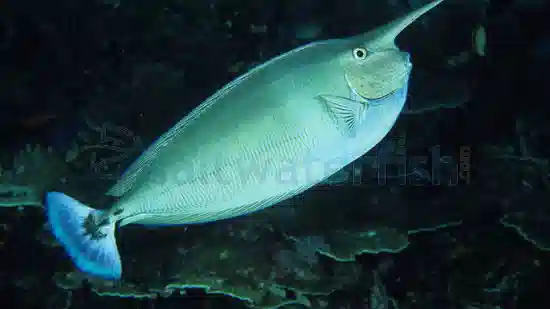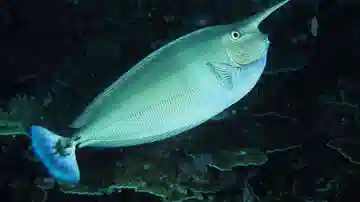Blue Unicorn Tang
Naso brevirostris
(2 Reviews)

Blue Unicorn Tang
Naso brevirostris
(2 Reviews)
{{ item.name }}
Size: {{ item.extra_field_3 }}
${{ getFormattedPrice(item.saleprice) }} ${{ getFormattedPrice(item.price) }}
To join the waiting list, click here
Free Shipping
With
$199.00
or more in Marine Life.
More details...
Blue Unicorn Tang Care Facts
| Care Level: | Moderate |
|---|---|
| Temperament: | Semi-Aggressive |
| Diet: | Herbivore |
| Origin: | Indo-Pacific Ocean |
| Acclimation Time: | 3+ hours |
| Reef Safe: | Yes |
| Minimum Tank Size: | 360 gallons |
| Max Size: | 24 inches |
The Blue Unicorn Tang (Naso brevirostris), also known as the Spotted Unicornfish, is a large, majestic Tang found among the Indo-Pacific Ocean. Their bodies range in color from grey to brown; some having striped or spotted designs. Most notable though is the elongated horn located inline with their eyes for which they are named. Reaching sizes of 24 inches, they should be housed in very large aquariums with plenty of room to swim. Their diet should consist of seaweed preparations or macro algae. They are best if not kept with other unicorn tangs, as they can be aggressive towards their own kind, but are peaceful towards other species.
Blue Unicorn Tang (Naso brevirostris) Care Guide
If you're an enthusiast of marine aquariums looking for a unique and striking addition to your underwater community, the Blue Unicorn Tang (Naso brevirostris) could be the perfect choice. This care guide provides crucial information about this species, from its natural habitat to dietary needs, tank conditions, compatibility with other marine life, and the advantages of purchasing it from Saltwaterfish.com.
Habitat of the Blue Unicorn Tang:
The Blue Unicorn Tang hails from the warm, tropical waters of the Indo-Pacific, particularly the region around the Hawaiian Islands. They are typically found in lagoons, seaward reefs, and clear waters, where they have access to coral formations, providing them shelter and an abundant food source.
The Blue Unicorn Tang and Its Reef Compatibility:
The Blue Unicorn Tang is considered a reef-safe species. They typically do not show a strong interest in corals or other sessile invertebrates. However, as with tang, they may graze on some algae types, so providing ample marine vegetation in your tank is essential to meet their dietary needs and prevent them from nibbling on your corals.
Size and Lifespan of the Blue Unicorn Tang
These tangs can grow to about 24 inches (60 cm) in length. In a well-maintained and adequately sized aquarium, they can have a lifespan of 15 years or more.
Diet in Captivity of the Blue Unicorn Tang
In captivity, the Blue Unicorn Tang is primarily herbivorous. Their diet should consist of marine algae, dried seaweed, and high-quality pellet foods designed explicitly for herbivorous fish. Offering a variety of foods ensures that they receive a well-rounded nutritional intake.
The Blue Unicorn Tang and Aquaculture
Blue Unicorn Tangs are not commonly available through aquaculture. As such, most specimens are wild-caught. However, sourcing them from a reputable supplier like Saltwaterfish.com is crucial to ensure their health and adjustability to aquarium conditions.
Compatibility of the Blue Unicorn Tang with Other Fish and Invertebrates:
These tangs are generally peaceful when kept with other fish and invertebrates in a large aquarium. They have been known to become territorial when they are the only tang in a tank, but introducing them to a well-structured community of marine life can help reduce this behavior.
Sexual Dimorphism of the Blue Unicorn Tang
Blue Unicorn Tangs do not exhibit sexual dimorphism, meaning that males and females have similar physical characteristics and coloration.
Juvenile to Adult Coloration Changes of the Blue Unicorn Tang
Juvenile Blue Unicorn Tangs typically have a striking appearance with a white body adorned with contrasting blue lines and patterns. Their coloration may deepen as they mature into adults, with a more pronounced bluish tint. The distinct 'unicorn horn' that gives them their name is evident in adult specimens once they reach sexual maturity.
Temperament of the Blue Unicorn Tang
These tangs are generally peaceful and coexist well with other species. However, they may exhibit territorial behavior when they are the only tang in the tank. The presence of multiple hiding spots and structures in the aquarium can help mitigate any territorial disputes.
Tank Requirements of the Blue Unicorn Tang
To ensure the well-being of your Blue Unicorn Tang, maintain a tank with a minimum size of 360 gallons (approximately 1300 liters). Adequate tank size is essential to provide them with space to swim and explore. Maintain water conditions with a pH level between 8.1 and 8.4, a salinity level of 1.020-1.025, and a stable temperature between 74-80°F (23-27°C). Adequate water flow and a well-functioning protein skimmer can help maintain water quality.
Common Names for the Blue Unicorn Tang
The Blue Unicorn Tang may also be known as the Unicorn Tang.
Compatible Tank Mates for the Blue Unicorn Tang
When choosing tank mates for your Blue Unicorn Tang, consider these five specific species that are less likely to provoke territorial conflicts:
- Powder Blue Tang (Acanthurus leucosternon)
- Sailfin Tang (Zebrasoma veliferum)
- Cleaner Wrasse (Labroides spp.)
- Foxface Rabbitfish (Siganus vulpinus)
- Flame Angelfish (Centropyge loricula)
Why Choose the Blue Unicorn Tang from Saltwaterfish.com:
When considering adding a Blue Unicorn Tang to your marine aquarium, sourcing it from Saltwaterfish.com offers several advantages. Saltwaterfish.com is known for providing healthy specimens that are well-acclimated to captive conditions. This decreases stress on the fish and increases the likelihood of successful acclimatization in your marine tank.
In conclusion, the Blue Unicorn Tang can make a stunning and peaceful addition to your marine aquarium, bringing a piece of Hawaiian waters to your home. With the right tank conditions, appropriate tank mates, and a varied diet, these fish can thrive and contribute to the beauty and vibrancy of your underwater community.
Reviewed by: Stacey Gillian on April 17, 2024
A cute, little, lively Blue Unicorn Tang that brings a lot of character to your tank. Seems to play well with others and makes a welcome addition while being an easy keeper.
Reviewed by: Melody Marshall on Dec. 31, 2021







